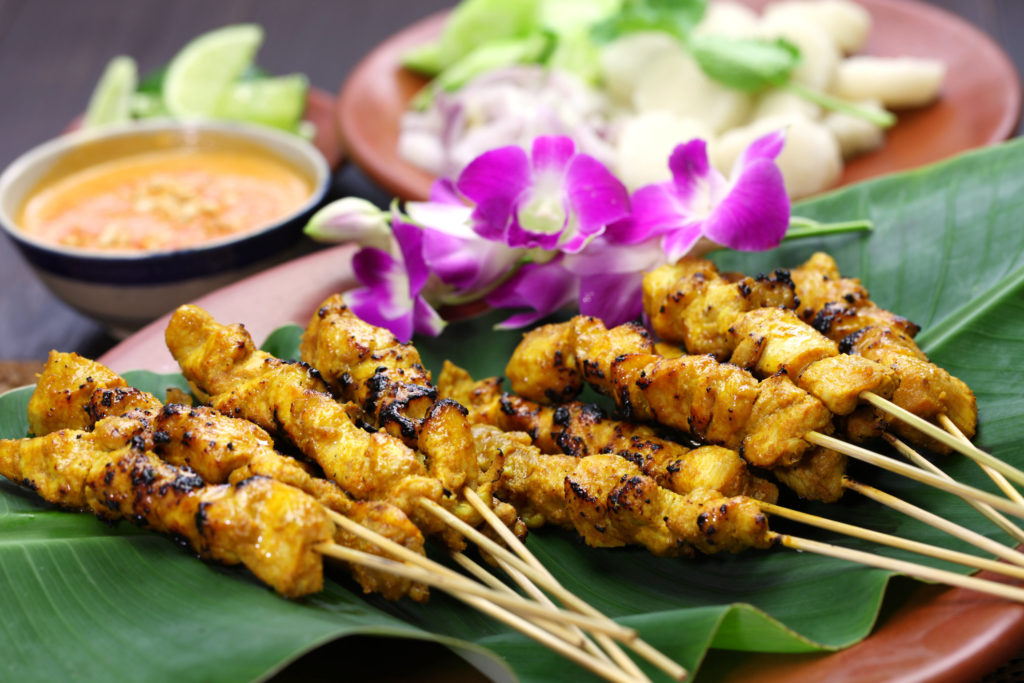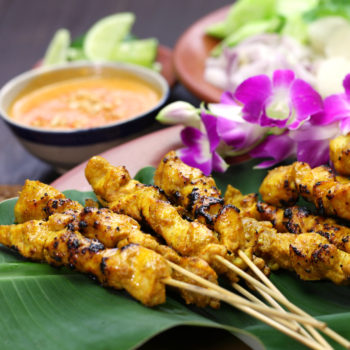Every year or so, Rico travels to Amsterdam… and always make a point to eat an unholy amount of Indonesian food. When he was there just a few weeks back, he invited along Vicky Hampton to explain why. She’s a British food journalist living in Amsterdam, and runs the blog Amsterdam Foodie (you might remember her voice from our segment on “War Fries” last year). Before heading in to a restaurant for an Indonesian feast, she and Rico talked a little about why this Southeast Asian cuisine has become a Dutch staple.

Vicky Hampton: Well, Indonesia was actually a colony of the Netherlands for about 150 years, between 1800 and the middle of last century. So the Dutch were in Indonesia for a long time, and consequently, a lot of Indonesian people have moved to the Netherlands.
Rico Gagliano: How would you characterize this food for those who don’t know it?
Vicky Hampton: Well, it involves, generally, a lot of spice, a lot of chilies, but also kind of warm spices. Peanuts feature very heavily — in salads, but also in the sauces. Coconut, as well, is popular. I mean, all the things that you think of in kind of tropical climates.
Rico Gagliano: And when you say “spicy,” you’re not kidding around.
Vicky Hampton: No, we’re not messing around. Usually, when they serve Indonesian food, they sort of start at the milder end, and then you work your way up, but I’ve seen many a person in tears.
Rico Gagliano: Also, I would say it’s, in a way, a bridge between Indian cuisine and the further East Asian cuisines, if that seems accurate to you. There’s, like, a little bit of Chinese in it. There’s a little bit of Indian in it…
Vicky Hampton: Yeah, I guess that’s kind of fair. I mean, I would say it’s maybe a little closer to Malaysian cuisine in terms of flavor — similarly spicy, and they also use tropical fruits and coconut and peanuts and that kind of thing.
![By Takeaway (Own work) [CC BY-SA 3.0], via Wikimedia Commons](../wp-content/uploads/2016/09/Rijsttafel_Den_Haag_Javastraat-768x1024.jpg)
Vicky Hampton: Yes. So, “rijsttafel” literally translates as “rice table,” and it’s essentially lots of different dishes — like small, almost tapas-sized dishes — that you share as a group, served with rice.
And, as we mentioned before, they kind of range from mild to extremely spicy, and it’s entirely an invention by the Dutch. The Indonesians do not actually eat this concept. I mean, they eat all the dishes individually, but not kind of all together in this way.
Rico Gagliano: And why? Where does that come from? I actually didn’t realize that; I thought that this was an Indonesian thing, a rijsttafel, but the Dutch made it up. For what reason?
Vicky Hampton: I think it stems from the colonial times when the Dutch wanted to show how rich and abundant their produce was and how much they could afford, and they wanted to show off to their friends.
Rico Gagliano: They’re like, “Check out all the exotic foods we just got from one of our colonies.”
Vicky Hampton: Exactly. So, they would put, like, 20 or 30 dishes on the table, whereas in Indonesia itself, people probably eat, like, two or three. And for some reason, this caught on…
Rico Gagliano: For some reason? It’s a whole bunch of delicious stuff all at once!
Vicky Hampton: Well, yes. And you can’t say no to that, can you?
Rico Gagliano: Definitely not. So, let’s go inside. We’re outside a restaurant called Jun in the west side of Amsterdam. My friend Diana is going to meet us here. She is part Indonesian, and maybe she can add a little something to the conversation.
Vicky Hampton: Sounds fantastic.
[Inside the restaurant.]
Rico Gagliano: So, our food is arriving. What do we have here?
Server: This is the chicken, red chicken. This is rendang…
Rico Gagliano: Rendang — this is one of the kind of main dishes of the cuisine.
Server: Yes; this is beef. And this one is the cucumber salad.
Rico Gagliano: Cucumber salad and…
Server: That’s the sayur tumis.
Rico Gagliano: Which is?
Server: Vegetables.
Rico Gagliano: That, I understand. Oh, and more stuff is coming out…
Server: Enjoy.
Rico Gagliano: So, Diana, so we’ve got, now, five dishes in front of us. I think we’ve got — ah! Here comes a sixth. That’s the satay, skewered chicken strips.

But, Diana, I wanted to ask you: one of the main dishes of the cuisine is this rendang — is that how it’s pronounced?
Diana Steenbergen: Yes. I never make it because it takes a day to make it. The beef has to fall apart. It has all these herbs in it, and it’s just simmering for a day. So, it really gets into the meat. I have no patience for this, to make this, but that’s why I go out and eat it!
Vicky Hampton: It’s like a spicy beef stew.
Rico Gagliano: And what is this?
Diana Steenbergen: She said “red chicken,” a version of curry chicken.
Rico Gagliano: It almost looks like an Indian curry, but I’m pretty sure it doesn’t taste that way. I’m going to start with some rendang. I’ve had this many times before, but it’s always a little different from place to place, as with any cuisine.
[Tastes dish.] Mmmmm, that is good. Ideally, it should be kind of fall-off-the-bone tender, yes?
Vicky Hampton: Yes, indeed.
Rico Gagliano: What should I do next? See, I was so busy talking to you guys and thinking about what I was going to say that I didn’t see what order of spiciness this was laid out. What would you say is the most likely thing to burn my face off?
Vicky Hampton: Well, I would say this red chicken curry that’s sitting in front of me, but Indonesian restaurants in Amsterdam are well known for kind of toning down their spice level, especially for foreigners. So you may find that you’re not going to get quite the head-blowing-off experience that you’ve been anticipating.
Rico Gagliano: The fact that I’m wearing a T-shirt that has an English word on the front of it — they may have been like, “Let’s just give that guy a break.”
Vicky Hampton: And doing a radio show in English with a bunch of people at your table!
Rico Gagliano: Diana, you have, actually, a story that I really love about spicy foods.
Diana Steenbergen: Yeah. When I was 16, I had my first boyfriend. He was from an Indonesian family. His father, who was Dutch, told me this story about the first time he went to his girlfriend’s house at his Indonesian in-laws’ to have dinner.
His mother-in-law, Indonesian woman, she made an extremely spicy dish just to test him to see if: “Are you spicy enough, or man enough, to hang out with my daughter?”
And he told me — I don’t know if this is true — but he told me that his taste buds that night got burned, and now he can handle spice. He can handle spice, anything, after that night.
Rico Gagliano: So, his taste buds got numbed so that now, nothing can harm him.
Diana Steenbergen: [agreeing] No.


